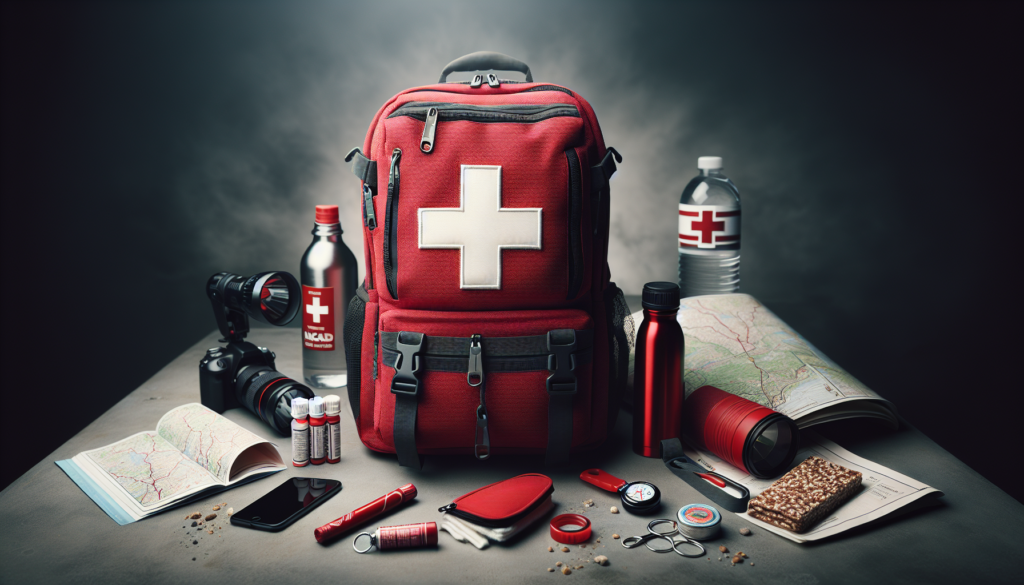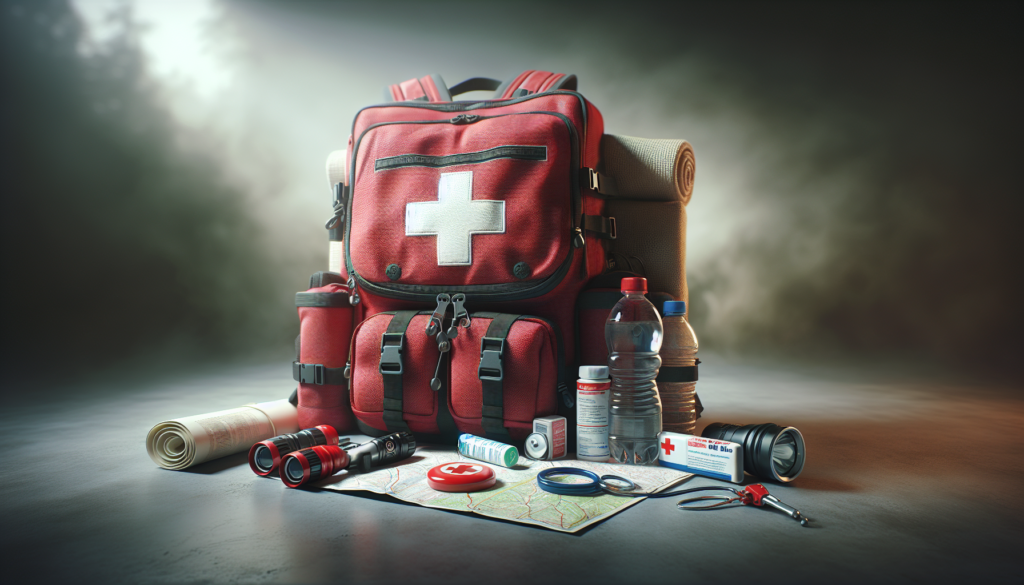Imagine being caught in a sudden emergency situation, with no access to electricity, communication or basic supplies. It may sound daunting, but with proper preparation and the right items in your emergency kit, you can ensure your safety and well-being during unexpected events. In this article, we will highlight the top 10 must-have items that should be included in your emergency kit, providing you with a sense of security and peace of mind in times of crisis.

Water
Water is one of the most important items to include in your emergency kit. When a disaster strikes, access to clean and safe drinking water may become limited or even nonexistent. In order to ensure you and your loved ones stay hydrated during an emergency situation, it is crucial to have a sufficient supply of water on hand.
Water Bottles
Having a supply of water bottles in your emergency kit is essential. These portable containers allow for easy access to clean drinking water. It is recommended to have at least one gallon of water per person per day for a minimum of three days. Choose water bottles that are made of durable, BPA-free plastic and ensure they are properly sealed to prevent any leaks or contamination. Remember to regularly check and replace the water bottles in your emergency kit to ensure they are safe to consume.
Water Purification Tablets
In addition to packed water bottles, it is wise to include water purification tablets in your emergency kit. These tablets are designed to neutralize harmful bacteria and viruses that may be present in untreated water sources. Simply follow the instructions provided on the packaging to effectively purify the water and make it safe for consumption. Water purification tablets are lightweight and compact, making them a valuable addition to your emergency kit.
Water Storage Containers
If you anticipate the need for a larger supply of water, consider including water storage containers in your emergency kit. These containers can hold a significant amount of water, allowing you to store and preserve it for an extended period of time. Choose containers that are made of food-grade plastic and have a tight-fitting lid to prevent any contamination. It is crucial to regularly sanitize and replace the water stored in these containers to ensure its freshness and safety.
Food
During an emergency situation, access to regular food sources may be limited or cut off entirely. It is crucial to have a supply of non-perishable food items in your emergency kit to keep you nourished and energized.
Non-perishable Food Items
Non-perishable food items are foods that have a long shelf life and do not require refrigeration. Items such as canned goods, granola bars, and dried fruits are excellent choices. Stock your emergency kit with a variety of non-perishable food items that cover different nutritional needs and preferences. Remember to regularly check the expiration dates on these items and replace them as needed.
Canned Goods
Canned goods are an excellent option for emergency food supplies. They are already cooked and ready to eat, providing you with a convenient and nutritious meal option. Choose canned goods that are high in protein, such as canned tuna, beans, or chicken. Don’t forget to include a manual can opener in your emergency kit to access these canned goods.
Energy Bars
Energy bars are compact and nutrient-dense, making them an ideal choice for emergency food supplies. They provide a quick source of energy and can help you stay fueled during challenging situations. Look for energy bars that are high in calories, protein, and fiber to keep you satisfied. It is important to regularly check the expiration dates on these bars and replace them when necessary.
Pet Food (if applicable)
If you have pets, it is important to include an ample supply of pet food in your emergency kit as well. Your furry friends also need to be nourished and it is crucial to have their specific dietary needs catered for. Make sure to choose pet food that has a long shelf life and is easy to store. Remember to regularly check and replace their food to ensure its freshness and suitability for consumption.

First Aid
In times of emergencies, injuries can happen. Having a comprehensive first aid kit in your emergency supplies is crucial in providing immediate care and potentially saving lives.
First Aid Kit
A well-stocked first aid kit is a must-have for any emergency situation. Ensure your first aid kit includes basic supplies such as adhesive bandages, gauze pads, adhesive tape, and scissors. Additionally, include items such as antiseptic ointment, disposable gloves, tweezers, and a thermometer. It’s also a good idea to include a first aid manual or guide that provides instructions on how to handle common injuries.
Bandages
Bandages are an essential component of any first aid kit. Make sure to include a variety of bandages such as adhesive strips, sterile gauze pads, and elastic bandages. These items are essential for treating cuts, scrapes, and larger wounds. Remember to regularly check and replace the bandages in your kit to ensure they are clean and ready for use.
Antiseptic Wipes
Antiseptic wipes are convenient and effective in disinfecting wounds or hands. They are individually packaged and sterile, making them a hygienic option for emergency situations. Include antiseptic wipes in your first aid kit to clean and sanitize wounds to prevent infection.
Prescription Medications
If you or any family members require prescription medications, it is crucial to have an ample supply of these medications in your emergency kit. Make sure to regularly check the expiration dates on these medications and replace them as needed. It is also important to consult with your healthcare provider on the appropriate storage conditions for these medications during an emergency.
Emergency Contact Information
In any emergency situation, having access to emergency contact information is crucial. Ensure that your emergency kit includes a list of important phone numbers such as your doctor, local emergency services, close relatives, and friends. It is also recommended to include important medical information, such as allergies or existing medical conditions, to facilitate prompt and effective medical assistance if needed.
Lighting
During an emergency, power outages are common, leaving you in need of alternative lighting sources. Including reliable lighting tools in your emergency kit is essential for maintaining safety and visibility.
Flashlights
Flashlights are a fundamental item for any emergency kit. Choose flashlights that are durable, reliable, and have a long battery life. LED flashlights are particularly recommended due to their energy efficiency and brightness. Additionally, make sure to store extra batteries alongside your flashlights to ensure an uninterrupted source of light.
Extra Batteries
In conjunction with your flashlights, it is important to stock up on extra batteries. Make sure to include batteries of different sizes to accommodate various types of handheld tools and devices in your emergency kit. Regularly check and replace the batteries to ensure they are in good working condition.
Glow Sticks
Glow sticks are a great alternative lighting source during power outages. They are safe, portable, and provide a steady glow for several hours. Include a few glow sticks in your emergency kit to provide illumination in dark or low-light situations. Remember to check the expiration dates on the glow sticks and replace them as needed.
Communication
Maintaining communication during an emergency is vital for obtaining up-to-date information and seeking assistance when necessary. Including the following communication tools in your emergency kit will help you stay connected.
Battery-Powered Radio
A battery-powered radio is an invaluable tool during emergencies. It allows you to receive important news updates and emergency alerts even in the absence of electricity. Choose a radio that can operate using a variety of power sources, such as batteries, hand-cranking, or solar power. Stay tuned to local emergency stations to stay informed about developments in your area.
Cell Phone with Charger
Your cell phone is an essential tool for communication during emergencies. Make sure to include a fully charged cell phone in your emergency kit. Additionally, pack a portable charger or a spare battery to ensure you have a way to recharge your phone when power sources are limited. It is recommended to keep important contact numbers saved in your phone or written down in case you need to dial them manually.
Whistle
A whistle may seem like a simple tool, but it can be a lifesaver during emergencies. It can be used to attract attention and signal for help when voice communication is not possible. Include a whistle in your emergency kit and make sure it is easily accessible. Teach everyone in your household how to use the whistle properly.
Emergency Contact List
Having a comprehensive list of emergency contact information is crucial during an emergency. Include important phone numbers such as emergency services, family members, friends, and neighbors in your emergency kit. It is also recommended to include any relevant medical information, such as allergies or medical conditions, to provide useful context in case of emergencies.
Shelter
In case you are unable to stay in your home or require temporary shelter during an emergency, it is important to have the necessary items to create a safe and comfortable living environment.
Emergency Blankets
Emergency blankets, also known as space blankets, are lightweight and compact. They are designed to retain body heat and provide insulation in cold or harsh conditions. It is recommended to include one emergency blanket per person in your emergency kit. These blankets are also effective in reflecting heat during hot weather.
Tarp
A tarp is a versatile and durable item that can be used to create temporary shelter, protect your belongings from the weather, or serve as a ground cover. Choose a tarp that is waterproof and large enough to accommodate your needs. Including a few extra ropes or cords in your emergency kit will help secure the tarp and create a sturdy shelter.
Tent
If space permits, including a small tent in your emergency kit is highly beneficial. Tents provide more stability, protection, and privacy than makeshift shelters. Look for a tent that is compact, lightweight, and easy to set up. Consider the number of people in your household and choose a tent that can comfortably accommodate everyone.
Duct Tape
Duct tape is an essential tool with a multitude of uses during emergencies. It can be used for sealing leaks, repairing damaged items, or securing temporary shelters. Make sure to include a roll of duct tape in your emergency kit for its versatility and reliability.
